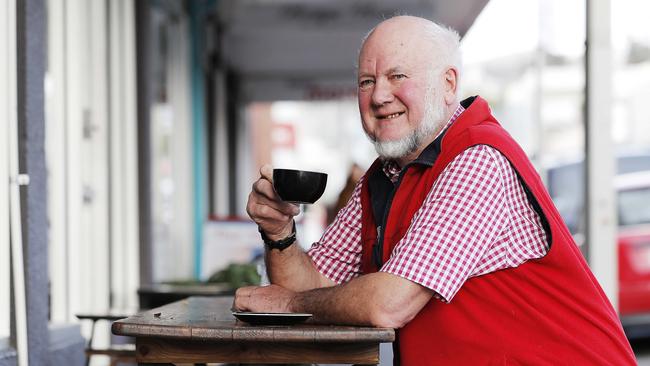Talking Point: Ailing health system needs full rebuild
The UTAS move to the CBD is a perfect opportunity to fix our struggling health system, argues a veteran physician.

Tasmania
Don't miss out on the headlines from Tasmania. Followed categories will be added to My News.
SO near and yet so far. That’s the way Dr Bryan Walpole AM sees the clustering of university College of Health and Medicine facilities just a stone’s throw from the Royal Hobart Hospital.
As the city prepares for the staged relocation of the rest of the Sandy Bay campus over the next decade, the former RHH director of emergency is calling for greater interaction between the institutions.
If we really want to improve health care in the state, we need to do more than just rebuild facilities such as our city’s public hospital and throw more money at the problem, he says.
If our ailing health system is to heal, we need to rebuild it by integrating its core elements under one administration and employer.
Let’s harness the impetus of the university’s epic shift to the city to create a statewide academic medical centre, Bryan suggests, bringing the state’s four public hospitals as well as the university’s learning and research centres under its umbrella.
He even has a name for it — The University of Tasmania Medical Centre — and he is confident the time is right to grab the tripartite model and run with it.
“We urgently need to bring clinical, education and research facilities together,” he says. When medical professionals habitually worked across areas, it vastly increased knowledge sharing and timely take-up of new technologies and treatments. Bryan worries that despite all the singular achievements, we are stagnating in a 20th century model.
“The answer is to have one overarching board that runs them all with a CEO, and that board appoints people to the combined unit.
“That’s what highly successful institutions do. That’s what happens in other places, including Oxford and Cambridge [universities], which each have a hospital. It’s a well-tried national and international model.”
It’s a holistic embrace from a veteran emergency physician who spent decades at the coalface, clocking up 30 years at the Royal. Bryan came to national prominence at the worst of times, as one of the emergency surgeons in charge on the day of the Port Arthur massacre 23 years ago.
MORE CAFE SOCIETY:
KATHERINE STREET: FLOURISHING IN A CHANGING LANDSCAPE
WARRICK BISHOP: A HELPING HAND FOR YOUR HEART
SHAMUS MULCAHY: MISSING ELEMENT IN HEIGHT DEBATE
CHRIS GWYNNE: HYDROPOWER TO TACKLE CLIMATE CHANGE
DAVID LEE: ANOTHER WAY OF LOOKING AT HIGHRISE
Having pulled back from the intense demands of emergency medicine, he works as a locum when he is not occasionally seafaring as a remote doctor on oil rigs or pondering the failures of the system he once operated within. As he shares his vision over coffee at Straight Up in Liverpool St, he relishes the chance to speak his mind, finally unencumbered by bureaucratic bans.
“When you are inside the system it’s very hard to talk about it because you will upset administration and maybe your colleagues,” he says, adding he keeps his ear to the ground in his extensive network.
“The current system is not working and all the things they are doing to fix it is tinkering at the edges when what is required is rebuilding. But that requires a lot of trust. Each organisation has to trust the other ones.”
Tasmania is “just the best place” for it to happen, he says.
“We have four public hospitals that are part of one administration. We have one university with three campuses around the state and we have two research centres.”
While the UTAS College of Health and Medicine website home page describes “close links with our community, our health system and our health professionals”, Bryan says much more could be done by all parties to forge a significantly more productive union. He says the hospital and research and education facilities operate as largely separate entities, despite their proximity to one another.
“Currently, they are separate silos,” he says. “The university employs its own staff to teach the medical, nursing and pharmacy students. The hospital employs its own staff to treat patients. And the Menzies employs its own researchers. Relatively few medical professionals are working across the institutions.”
Bringing them together could also simply complex funding arrangements, he says. If the convergence sounds ambitious, it is. But Bryan says it’s also achievable, pointing to “highly successful” precedents forged interstate, including between Melbourne’s Alfred Hospital, Monash University and Baker Institute.
“The Baker research institute and the medical school are partly in the grounds of the hospital. And when you go there [to work as a medical professional], they say, here’s your teaching, here’s your clinical work and here’s your research work.
“Academics are more likely to know the best way of doing something because they are at the cutting edge of research.”
Bryan predicts the recent ministerial reshuffle, with Sarah Courtney replacing Michael Ferguson in the state health portfolio, will make little difference to the ongoing hospital crisis and the chronic bed block besetting it.
You can’t fix a broken system, he says. “The two fundamental questions are: is Treasury going to open up its wallet? And [will we] fundamentally organise the way we do things.”


